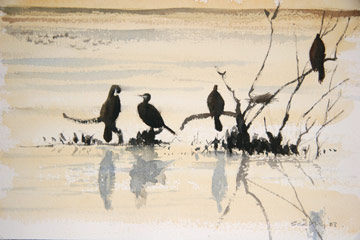
Cormorant © Ray Scally
This winter Atlas map would have come as a great surprise to earlier generations of ornithologists. A century ago it was something of an event to record a Cormorant inland, although they were regular non-breeding residents at the coast (Coward 1910). Writing in 1951, Boyd noted that ‘thirty years ago Cormorant was seldom seen on the meres, but it has become a much more regular visitor in the last ten years in every month of the year’. The largest inland flock known to Bell (1962) was 44 birds at Tatton, but he thought that numbers had not increased since the 1940s. They must have not reached east Cheshire because a single bird seen in February 1961 on Langley Reservoirs was suggested as indicating an extension of range (Bell 1962). Bell (1967) noted a rise in numbers at Rostherne since the National Trust took over Tatton, and a count at Rostherne of 28 birds in April 1963 was thought noteworthy. Although the move inland drew most comment, Bell (1967) pointed out that they were seen throughout the year at the coast, with highest numbers in autumn and winter, with up to 500 at Hilbre in winter 1957/ 58 as an exceptional count.
This Atlas map shows Cormorants to be widespread across the county, at the coast, both estuaries, the major rivers and most of the meres and lakes, including regularly in small numbers on the upland reservoirs. The shift inland is illustrated by the submitted habitat codes, showing that only one-quarter of the occupied tetrads were marine or estuarine, with three-quarters of them freshwater. The latter comprised about one-third on linear waterways and two-thirds on meres, sandpits and other waterbodies. However, the largest numbers are still in the Dee estuary, where the WeBS counts show a five-year peak mean of almost 700 birds, the fourth highest for any site in the UK (Musgrove et al 2007). Cormorants often gather into large flocks, but of the 314 counts submitted for this Atlas, half of them were of four birds or fewer. There were just twenty counts of 50 or more, with the largest flocks 420 birds off Hilbre (18Z) in 2006/ 07 and 300 birds in SJ28C (off Caldy) in 2004/ 05. Cormorants do not need to spend much of their time fishing, and many of the larger counts came from their diurnal roosts, birds perching prominently on trees (often dead trees) or electricity pylons, or standing on a sandbank. 212 birds were in the roost at Rostherne (SJ78M) in 2004/ 05, almost ten times the figure of forty years before.
Our wintering birds are mostly from colonies around the Irish Sea (Migration Atlas). Outside the breeding season, adults may move 100 km or more from their colony, and immature birds, below breeding age, disperse similar distances or farther. The index of wintering numbers in Britain, from WeBS counts, has shown a steady increase from the mid-1980s to 2003/ 04, but might have levelled off in recent years.
Cormorants’ diet is almost exclusively fish, with a few crustaceans and amphibians, perhaps taken incidentally. At sea, they stay close to land and mostly take flatfish, sandeels and cod. Inland, they especially favour roach and perch. The Cormorants’ move to breeding and wintering inland in the UK is an apt metaphor for man’s abuse of the environment. Man has overfished the seas and overstocked some inland waters; it is not surprising that this adaptable seabird has responded.
With their diet almost exclusively fish, however, some of the birds have made a nuisance of themselves by fishing in areas where angling clubs have stocked the waters, and some anglers have campaigned to be allowed to kill Cormorants, stigmatising them with the name ‘Black Plague’. In recent years the UK Government’s Department for Environment, Food and Rural Affairs has issued some licences for shooting Cormorants. Their guidance states that a shooting licence will only be issued to reinforce the effects of scaring measures being carried out at a site where: there is clear evidence that serious damage is being caused by cormorants, or on recent past evidence, that it is likely to occur; other non-lethal measures have been found to be ineffective or impracticable; other factors are not likely to be responsible for the serious damage; shooting will be successful in reducing the damage, and there is no other satisfactory solution.
Sponsored by A M Broome

